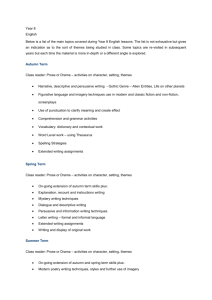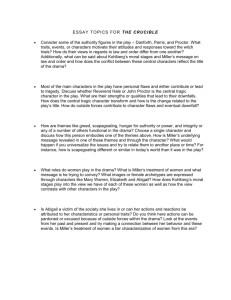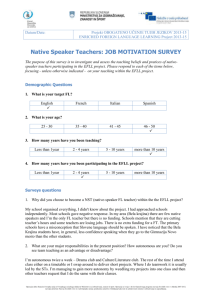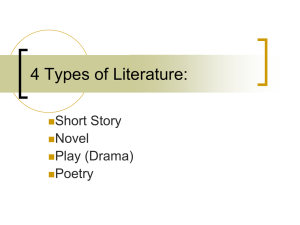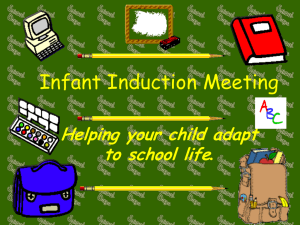English Literature III COURSE SYLLABUS Prerequisite: Successful
advertisement
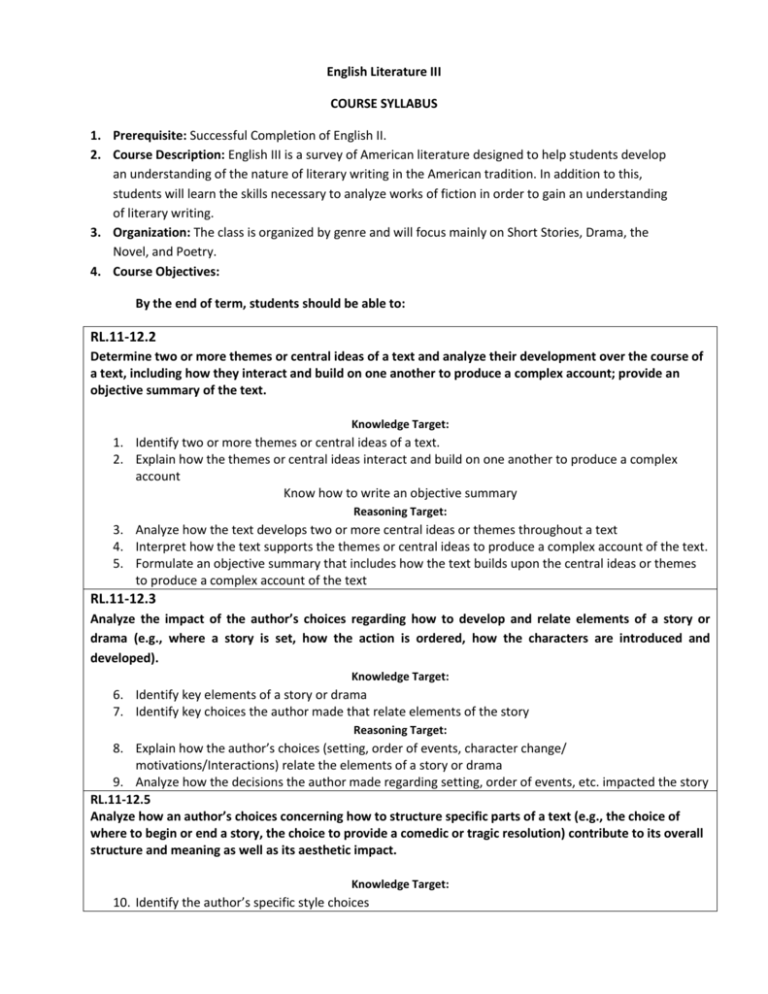
English Literature III COURSE SYLLABUS 1. Prerequisite: Successful Completion of English II. 2. Course Description: English III is a survey of American literature designed to help students develop an understanding of the nature of literary writing in the American tradition. In addition to this, students will learn the skills necessary to analyze works of fiction in order to gain an understanding of literary writing. 3. Organization: The class is organized by genre and will focus mainly on Short Stories, Drama, the Novel, and Poetry. 4. Course Objectives: By the end of term, students should be able to: RL.11-12.2 Determine two or more themes or central ideas of a text and analyze their development over the course of a text, including how they interact and build on one another to produce a complex account; provide an objective summary of the text. Knowledge Target: 1. Identify two or more themes or central ideas of a text. 2. Explain how the themes or central ideas interact and build on one another to produce a complex account Know how to write an objective summary Reasoning Target: 3. Analyze how the text develops two or more central ideas or themes throughout a text 4. Interpret how the text supports the themes or central ideas to produce a complex account of the text. 5. Formulate an objective summary that includes how the text builds upon the central ideas or themes to produce a complex account of the text RL.11-12.3 Analyze the impact of the author’s choices regarding how to develop and relate elements of a story or drama (e.g., where a story is set, how the action is ordered, how the characters are introduced and developed). Knowledge Target: 6. Identify key elements of a story or drama 7. Identify key choices the author made that relate elements of the story Reasoning Target: 8. Explain how the author’s choices (setting, order of events, character change/ motivations/Interactions) relate the elements of a story or drama 9. Analyze how the decisions the author made regarding setting, order of events, etc. impacted the story RL.11-12.5 Analyze how an author’s choices concerning how to structure specific parts of a text (e.g., the choice of where to begin or end a story, the choice to provide a comedic or tragic resolution) contribute to its overall structure and meaning as well as its aesthetic impact. Knowledge Target: 10. Identify the author’s specific style choices 11. Identify aesthetic impact: (e.g., historical context emotional appeal and artistic appeal) Reasoning Target: 12. Analyze how the author’s choices contribute to the: overall structure meaning aesthetic impact RL.11-12.7 Analyze multiple interpretations of a story, drama, or poem (e.g. recorded or live production of a play or recorded novel or poetry), evaluating how each version interprets the source text. (Include at least one play by Shakespeare and one play by an American dramatist). Knowledge Target: 13. Define source text 14. Identify two or more interpretations of text (story, drama, poem) Reasoning Target: 15. Explain multiple interpretations: recorded/live play recorded novel recorded poetry of (story, drama, poem) analyzing how each interprets source text 16. Evaluate how an artist chooses to interpret an entire work RL.11-12.9 Demonstrate knowledge of eighteenth-, nineteenth- and early-twentieth-century foundational works of American literature, including how two or more texts from the same period treat similar themes or topics. Knowledge Target: 17. Describe the historical context of ______________ (18th, 19th, or 20th) century 18. Identify foundational works of _______________ (18th, 19th, or 20th) century Distinguish between theme and topic Reasoning Target: 19. Determine the theme or themes of foundational works of American Literature 20. Compare/contrast the treatment of similar themes from two or more texts from the ______________ (18th, 19th, or early 20th) century 21. Compare/contrast the treatment of similar topics from two or more texts from the ____________ (18th, 19th, early 20th) century W.11-12.3 Write narratives to develop real or imagined experiences or events using effective technique, well-chosen details, and well-structured event sequences. a. Engage and orient the reader by setting out a problem, situation, or observation and its significance, establishing one or multiple point(s) of view, and introducing a narrator and/or characters; create a smooth progression of experiences or events. b. Use narrative techniques, such as dialogue, pacing, description, reflection, and multiple plot lines, to develop experiences, events, and/or characters. c. Use a variety of techniques to sequence events so that they build on one another to create a coherent whole and build toward a particular tone and outcome (e.g., a sense of mystery, suspense, growth, or resolution). d. Use precise words and phrases, telling details, and sensory language to convey a vivid picture of the experiences, events, setting, and/or characters. e. Provide a conclusion that follows from and reflects on what is experienced, observed, or resolved over the course of the narrative. Knowledge Target: 22. 23. 24. 25. 26. Define tone Recognize how writers relate the significance of a problem, situation, or observation to a reader Identify multiple points of view in narratives Recognize multiple plot lines in narratives Recognize techniques writers use to build toward a particular outcome Reasoning Target: 27. 28. 29. 30. 31. 32. 33. 34. Analyze how writers create tone Develop a sequence of events that creates a desired tone and outcome Determine appropriate techniques to relate significance. Analyze: multiple points of view of various narratives use of multiple plot lines in narratives Use a variety of techniques to logically sequence and connect events Analyze the relationships among experiences and events Design an organized sequence of events with dialogue to develop experiences, events, and/or characters Use precise, descriptive, and sensory language to develop vivid images of experiences, events, setting, characters Develop conclusions that reflects on what is experienced, observed, or resolved in a narrative Product Target: 35. Write a narrative that: creates a particular tone engages the reader with a significant problem, situation, or observation and introduces a narrator and/or characters establishes multiple points of view creates a desired tone uses techniques such as dialogue, pacing, description, reflection, and multiple plot lines to develop experiences, events, characters and build toward a particular outcome uses a variety of transitions to develop a coherent sequence of events uses appropriate precise, descriptive, and sensory language includes a reflective conclusion that flows from what is experienced, observed, or resolved L.11-12.5 Demonstrate understanding of figurative language, word relationships, and nuances in word meanings. a. Interpret figures of speech (e.g. hyperbole, paradox) in context and analyze their role in text. b. Analyze nuances in the meaning of words with similar denotations. Knowledge Targets: 36. 37. 38. 39. Define figures of speech (e.g. hyperbole, paradox) Recognize figures of speech within the text Identify words with similar denotations Recognize nuances in the meaning of words with similar meanings Reasoning Targets: 40. 41. 42. 43. Interpret figures of speech (e.g. hyperbole, paradox) Analyze the role of figurative language within the text Determine how figurative language impacts a text’s purpose Analyze nuances in the meanings of words with similar denotations 5. Required Text and Supplies: a. Three Ring Binder or Pronged Folder b. 1 Piece of Poster Board c. Pencils and Paper d. Jump Drive/Flash Drive (optional) 6. Course Web Page & Resources : a. www.edmodo.com b. http://www.fleming.kyschools.us/olc/teacher.aspx?s=252 7. Evaluation of Student Achievement: a. Grading Policy: i. Standards Based Grading b. Attendance: i. Attendance is a vital part of student success! It is imperative that students are present each day. If this is not possible, students need to make arrangements to stay for tutoring to make up class time. c. Missed Exams and Late Assignments: i. If a student misses school, it is their responsibility to make up missing assignments and exams. Missing assignments can be found on either the class webpage or on Edmodo. d. Extra Credit: i. There will be NO extra credit for this course. e. Academic Dishonesty: i. Students are expected to do their own work to the best of their ability. They will be expected to use the rules of proper citation at all times. Students that cheat or plagiarize will be reprimanded using the school/district plagiarism policy. 8. Classroom Rules of Conduct: a. Students are expected to come to class prepared each and every day. This includes bringing all class materials and being in their seat doing the bell work when the bell rings. Students who are not in their seat when the bell rings will be counted tardy. b. Students are expected to meet deadlines and turn in work when it is due. Students that do not have homework when it is due will be required to stay for After School Detention to finish missing assignments. 9. Schedule: Date/Week Topic/Activity Standard(s) Week 1 Week 2 Community Building Short Stories & Structure – Not Just Freytag’s Pyramid Of Mice and Men – Elements of Fiction None RL.11-12.5 Week 3 RL.11-12.3 Assignments/Due Dates Literacy Autobiography Story Structure Analysis - Other Novel Analysis (Elements of Fiction) Week 4 RL.11-12.2 LDC Task RL.11-12.2 LDC Task RL.11-12.7 RL.11-12.9 RL.11-12.9 L.11-12.5 Compare and Contrast Essay (Possible LDC Task) Compare and Contrast Essay (Possible LDC Task) Test Test Poetry Analysis W.11-12.3 Personal Narrative Week 12 Fahrenheit 451 – The Importance of Knowledge Fahrenheit 451 – The Importance of Knowledge Shakespeare, American Drama and the Production Shakespeare, American Drama and the Production The American Tradition The American Tradition The Language of American Poetry Your American Experience Digital Experience W.11-12.3 Digital Story On-Going Bell work ACT Practice All Standards Every Day Week 5 Week 6 Week 7 Week 8 Week 9 Week 10 Week 11 RL.11-12.7 10. Final Exams: Final Exams count for 20% of the grade for the course. 11. Learning Tips & Suggestions for Success: Be prepared for class each and every day, this includes being up to date on reading assignments. Do not put things off until the last minute. 12. How to Contact the Instructor: email – leslie.workman@fleming.kyschools.us or via Edmodo.
